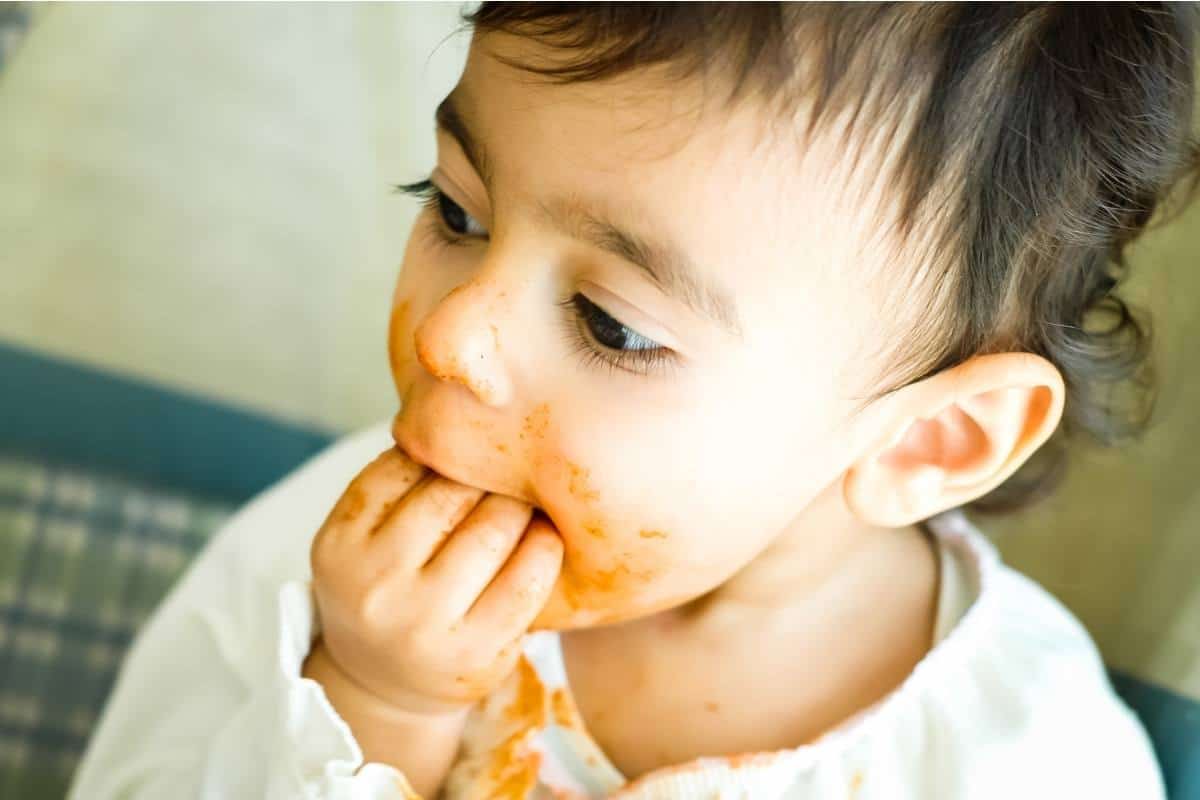Here at Happy Healthy Eaters, we’re big fans of allowing babies the opportunity to self-feed.
So, so, so, so, so sooooo many of you have flooded our DMs with questions like…”I don’t think my daughter has gotten the memo about swallowing her food. We let her self-feed but she just stuffs more and more pieces inside her mouth until she looks like a chipmunk! What should I do?”
Okay, so the truth is that no one has actually compared their child to a chipmunk but we thought that was a good visual to include 🙂
If you’re reading this, you likely relate to the parents who have asked us for help with this challenge. In this article, you will come away with several strategies you can use to help your child learn to chew and swallow their food before adding more to their mouth!
But first, we need to let you know what NOT to do!
Please, DO NOT take your finger and sweep the food out of your child’s mouth. Ironically, this could actually do what you’re trying to prevent: a choking incident. You may inadvertently push a piece of food back into your child’s airway.
If your child appears unable to clear the food out of their mouth, you can model to them what it looks like to spit food out by exaggeratedly sticking your tongue out and saying “blah!” You’ll look silly, but who cares.
Now that we’ve gotten that out of the way…here’s what you can do to help!
Offer Less Food… at a time!
Help your child to control the pace of their eating by limiting the amount of food they can reach. Keep a re-fill bowl or plate nearby and only place a few pieces of food in front of your baby. Once they’ve successfully swallowed those pieces, offer a few more pieces.
You can squish some food onto a learning spoon (such as the Gootensil) and pass it to your child. Once they’ve eaten it you can refill it for them. It may be helpful to have more than one utensil so that you can get one ready to go while your child is working on the previously filled one.
For older babies who are working on their pincer grasp, it may be time to downgrade the size of their food and offer small, pea-sized pieces. The larger, finger size pieces were great when they only had their palmar grasp but if all they’re doing is shoving the whole thing in their mouth, then that shape isn’t working for them anymore! Needing to use their pincer grasp can help to naturally slow the pace of their eating.
Offer More Food… at a time!
Yes, this is the exact opposite recommendation from what we just said! But guess what? Each baby is unique in how they approach food and will have their own unique reason for stuffing food. For some babies, they feel some scarcity if there’s only a little bit of food in front of them and they shovel it in so that you will replenish it. So for these babies it may be helpful to put a larger amount of food in front of them so they can relax and see that there’s plenty of food for them to eat!
Suggested Reading: Baby throwing food on the floor? Try these 8 tips!
Make Your Baby “Work” For Their Food
One way to naturally slow the pace of your child’s eating is to offer foods he has to work at getting! The following foods will require a bit of patience from your child to get it off the base.
- Spare ribs
- Drumsticks
- Corn on the cob
- Mango pit
*note: These foods may require some modification to be served safely. We have video tutorials in our e-course Start Solids Confidently for how to offer these foods to your baby.

Make sure your baby is comfortable
If your baby is not comfortably seated in their high chair, she may rush through her meal in order to get her fill before she tires out. What makes a baby comfortable? Not soft squishy pillows, if that’s what you were thinking! The answer is a foot rest! I (Jess) only learned about the importance of a properly adjusted foot rest after my babies grew out of their high chairs. We had a high chair without a footrest and I thought it was just *so cute* how my boys would cross their legs at the ankles. Little did I know that this was actually their way of compensating for feeling a bit unstable! Oops!
This 20 second reel might also be helpful for you! Who knew high chair ergonomics could be so complex!
Give Your Baby Teether Toys
Teething toys do so much more than just help soothe babies who are sore from getting new teeth! They help your baby increase the awareness in their mouth. Some babies stuff their mouths with food because they want to add pressure in their oral cavity to get a sense of where things are.
When a teether presses down on a baby’s gums and cheeks, her brain starts to figure out where in space that part of her body is.
To add, we want your baby to be able to push food to the sides of their mouth – this is called lateralization – that’s where the magic of chewing happens (with or without teeth!).
Teethers can definitely play a role in helping babies to develop chewing motions!
Here are some of our favourite teethers:

Exaggeratedly Model Chewing
You heard it here first, people: babies learn by watching their parents! Just kidding… you probably already know that role modeling behaviour you want to see in your child is an important way for them to adopt those behaviours! But sometimes babies need a bit more of an exaggerated demonstration!
You can show your baby how you place a small amount of food in your mouth and then do an exaggerated chewing motion. Then swallow the food and open your mouth to show your baby that the food is gone!
And let’s face it…. Many of us are probably modeling the exact behaviour we DON’T want our babies to do: we take large bites of food and don’t chew it adequately before swallowing it!

Alright… your turn! Does your baby stuff food in his mouth? Which of these strategies will you try? And do you have any other helpful ideas to share that have worked for your baby?
In the spirit of transparency, this post includes affiliate links which means we make a small amount of money for sales. This allows us to continue to be in the space and offer up great content. Thank you for supporting our mission.






